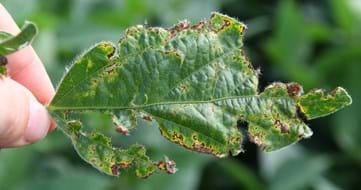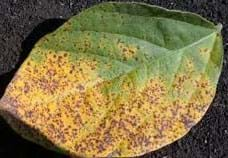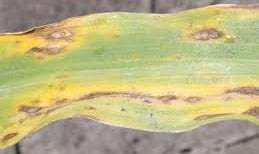Agronomy Update: Leaf Diseases & Farmyard Maintenance
BY DAIRYLAND SEED AGRONOMY TEAM
Bacterial Leaf Blight in Soybeans
Terry Jones, Eastern Region Agronomist
The presence of bacterial leaf blight (BLB) in soybeans is a very common disease that is fairly widespread this growing season. As with anthracnose leaf blight in corn, hard splashing rainfall, high humidity, fog and moderate to cool temperatures are all conducive to its development.

The presence of bacterial leaf blight (BLB) in soybeans is a very common disease that is fairly widespread this growing season. As with anthracnose leaf blight in corn, hard splashing rainfall, high humidity, fog and moderate to cool temperatures are all conducive to its development.
Septoria Brown Spot
Dan Ritter, Central Region Agronomist

Septoria brown spot (SBS) is a disease we see to some certain level each year. It usually appears lower in the soybean canopy and causes little economic issues. The reason being is that it attacks leaves lower in the canopy later in the season. These leaves tend to contribute little to yield at that point in time. There are years where weather favors its development a bit more and it can become a factor. In those years it tends to be cooler and more damp. It is characterized by lower leaves turning yellow and brown spots or speckles on the leaf.
The weblink below has some additional information related to SBS and bacterial leaf blight.
https://www.canr.msu.edu/news/bacterial_blight_and_septoria_brown_spot_appearing_in_soybeans
Anthracnose Leaf Blight in Corn
Terry Jones, Eastern Region Agronomist
 |
 |
Anthracnose leaf blight (ALB) has become a very prominent foliar disease for the 2019 growing season. Many fields were infected by growth stage V3 this year and it has continued to spread into the upper canopy later in the season. ALB overwinters on infected residue from previous corn crops and is spread from wind and hard splashing rainfall. ALB first appears as water-soaked spots with tan centers and reddish borders. Under warm temperatures and prolonged rainfall, high humidity or fog, ALB can expand to possibly defoliate leaves. Fields with ALB should be monitored for the potential for anthracnose stalk rot.
ALB appears to become worse in nutrient deficient environments. Possible management strategies include burying corn residue, crop rotation, avoid using susceptible hybrids back to back if residue was infected with ALB. Using a fungicide labeled for ALB for early infection may be beneficial. Later applications of a fungicide may also prove a benefit if the upper canopy is at risk of defoliation.
Turf Management
Brian Weller, Western Region Agronomist
As September continues and moves into October, harvest has started in some areas with others still waiting for it to begin. Working in agriculture has not always been conducive to having a great lawn or landscaping. Late summer and early fall are great times to get a jump on lawn care for next spring/summer.
- Mowing: start taking your mowing height down for the fall. I like to have about 2.5” of grass or slightly less. By keeping your mower height deck down, it gives less areas for voles/moles to live in. Another advantage of shorter grass is you also reduce the potential for molds or disease to affect your lawn. If you have grass that is 6” tall you do not want to take it down to 2.5” in one cutting, it is best to do so in several cuts, also try not to cut the grass too short or scalping the grass, this ends up killing the grass in many cases.
- Mower Blades: fall is a great time to get new blades or to sharpen those currently on the mower. Many turf professionals are sharpening blades every 30-40 hours of use, in some cases they are cutting that timeframe in half, and sharpening every 15-20 hours of use. Sharp blades make for a more efficient mower as well as healthier grass that is less likely to have disease or molds.
- Dethatching: if you can get the layer of thatch off the lawn, you reduce the chance for having disease’s in your lawn, much like a row crop many diseases are found in the residue. By removing thatch, you are also reducing the vole/mole issue.
- Leaves: by raking leaves you reduce the vole/mole issue but also the leaf residue from smothering or killing the grass. In my experience leaves mixed into a garden or field increase the soil tilth in that area.
- Weeds: late summer or early fall is a great time to kill or reduce perennial broadleaf weeds like Common Dandelion, Thistle species, and Creeping Charlie. A herbicide application (or two) in the fall goes a long way in killing and reducing these problem weeds compared to just a spring application. Many of these problem weeds will take 3-5 applications over the course the year to help remove these pests, 1-2 applications in the fall followed by 2-3 in the spring or early summer.
- Fertilizing: much like farm fields, lawns need to be fertilized, and fall is a great time to get this done. Lawns with proper fertility tend to overwinter better and have a better start in the spring compared to ones that do not. If you are unsure as to what your lawn is lacking in fertility, a simple soil test goes a long way in showing what is needed.
- Water: you do not want to overwater, but if you have not received rainfall in the last 7-10 days and air temperatures are in the 60°F or above, you may want to put .25” to .5” on during the morning hours.
Besides the lawn, trees, shrubs and other perennial plants will need water and fertilizer to increase their lifespan. Watering newly transplanted trees, shrub and other plants prior to freeze up will help the plant overwinter.
 |
 |
 |
 |
 |
| Brian Weller Western Region 507.456.3034 |
Dan Ritter Central Region 219.863.0583 |
Branden Furseth Northern Region 608.513.4265 |
Rod King Eastern Region 574.596.6721 |
Terry Jones Eastern Region 419.630.3115 |
